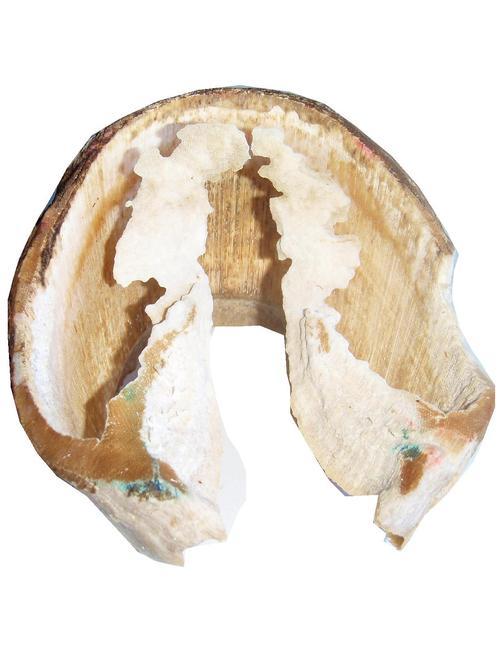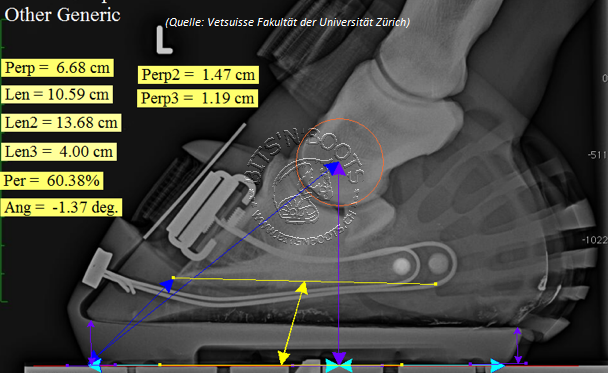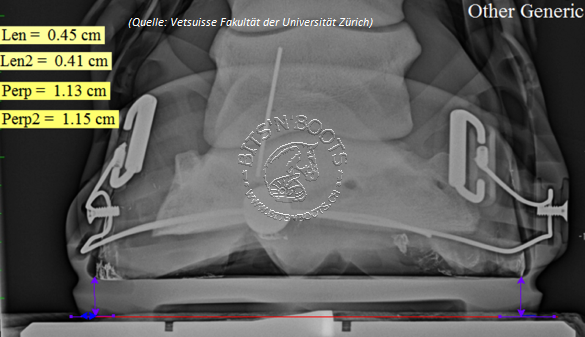I cannot document every single foot, so here is Gus front right, which I have used a lot in illustrations before, most recently in the entries about bar smear. Gus is extremely sound right now. He has one small general problem, that is really really really hard to get rid of, and this is that his coffin bone must have a small crena (center notch), that causes a small hole in the tip of the toe sole and sometimes a very small crack in his dorsal wall. I am treating it as much as I can, to prevent fungus to grow in there, but it is so small that any treatment is rather inefficient. Since my horses live on a sand dune, the sand packs in even the smallest place and so it is really difficult to keep the sand out of that small hole. In fact, it is impossible. The good news is that this small crack does not seem to bother him at all and so I will not worry about it right now, but obviously keep an eye on it. I measure at every trim how far away it is from the coronary band, and so far it is very constant and never changes.
There is some disagreement amongst hoof care providers on whether this crena represents some pathology due to, for example, toe clips in metal shoes or whether it represents an evolutionary relict of modern horses from their ancestors. I think the consensus is that the latter is the case in general, but that there is substantial variation amongst horses in the extend to which this crena exists in the coffin bone. And of course, bone degradation can also happen for example due to laminitis and founder. The best evidence I know of is the fossil record itself. Neohipparion, an ancestor of the modern horse lived 5-16 Million years ago, in North and Central America: https://www.flmnh.ufl.edu/fhc/neoh.htm
The coffin bone of the specimen available at Natural History Museum in Florida shows a very pronounced center notch:
During the further evolution of the modern horse, the center notch became gradually smaller and smaller. But some modern horses still have a clear center notch. And Gus is one of them. He never wore shoes in his whole life, so I can rule out that damage was caused by a toe clip. He also never had laminitis or founder. In his case, I think it is pretty clear, it is just a relict of the ancestors in his genes.
In any case, the picture below shows Gus' front right sole. I have just cleaned it with a wire brush. All loose sole gets easily removed with the wire brush, but what is hard and well attached remains. Normally, I would probably start taking those ridges of sole around the apex of the frog down to make them flush with the sole around it. They have a lot of cracks (not very deep cracks though). In the last 2 years I have been rather conservative with those ridges of sole, as I noticed when I take them down rather aggressively, to make things look "nice and pretty" he is actually a bit outchy on the compressed hard sand on my sand dune. At some point I need to write something about hooves living on a sand dune. Very briefly, a thin sole does do very poorly on wet, packing sand. I believe that this is why my horses grow this rather massive ridges of sole around the apex of the frog, every time, consistently, for the past 4 years now. Everytime they have them rather prominently they are as sound as can be. And Gus is doing very well on all surfaces.
There is some disagreement amongst hoof care providers on whether this crena represents some pathology due to, for example, toe clips in metal shoes or whether it represents an evolutionary relict of modern horses from their ancestors. I think the consensus is that the latter is the case in general, but that there is substantial variation amongst horses in the extend to which this crena exists in the coffin bone. And of course, bone degradation can also happen for example due to laminitis and founder. The best evidence I know of is the fossil record itself. Neohipparion, an ancestor of the modern horse lived 5-16 Million years ago, in North and Central America: https://www.flmnh.ufl.edu/fhc/neoh.htm
The coffin bone of the specimen available at Natural History Museum in Florida shows a very pronounced center notch:
During the further evolution of the modern horse, the center notch became gradually smaller and smaller. But some modern horses still have a clear center notch. And Gus is one of them. He never wore shoes in his whole life, so I can rule out that damage was caused by a toe clip. He also never had laminitis or founder. In his case, I think it is pretty clear, it is just a relict of the ancestors in his genes.
In any case, the picture below shows Gus' front right sole. I have just cleaned it with a wire brush. All loose sole gets easily removed with the wire brush, but what is hard and well attached remains. Normally, I would probably start taking those ridges of sole around the apex of the frog down to make them flush with the sole around it. They have a lot of cracks (not very deep cracks though). In the last 2 years I have been rather conservative with those ridges of sole, as I noticed when I take them down rather aggressively, to make things look "nice and pretty" he is actually a bit outchy on the compressed hard sand on my sand dune. At some point I need to write something about hooves living on a sand dune. Very briefly, a thin sole does do very poorly on wet, packing sand. I believe that this is why my horses grow this rather massive ridges of sole around the apex of the frog, every time, consistently, for the past 4 years now. Everytime they have them rather prominently they are as sound as can be. And Gus is doing very well on all surfaces.












































